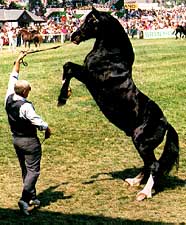Welsh Cob (Section D)
N/A
Sat, 12th July, 2025 - 6:01 am GMT
Sponsor Ads:

Alternative Name
N/ABasic Info
(14:2hh to 15:2hh) The head shows great quality with Pony character. Bold prominent eyes, a broad forehead and neat, well set ears. The body must be deep, on strong limbs with good "hard wearing" joints and an abundance of flat bone.
Health
N/AHabitat
N/ABehavior
The general character of the Welsh Cob is the embodiment of strength, hardiness and agility. Action must be straight, free and forceful, the knees should be bent and then the whole foreleg extended from the shoulders and as far forward as possible in all paces, with the hocks well flexed, producing powerful leverageThe Welsh Cob is a good hunter and a most competent performer in all competitive sports, in recent years they have had great success in the International driving world. Their abilities in all spheres are now fully recognized throughout the world. Up until 30 or 40 years ago, the Welsh Cob was so valuable to the British War Office that premiums were paid to the best stallions. The War Office used the Cobs for the mounted infantry and for pulling heavy guns and equipment through rugged, mountainous terrain not easily surmounted by motorized vehicles. In peace, the Welsh Cob (prior to motorized vehicles) was the quickest transport for doctors and businessmen. Quite often, the sale of a Cob was dependent on how quickly he could cover a predetermined distance without laboring. This also forged the way for many of the famous old trotting matches, such as were used to test the original Morgan Horse.Origin
WalesHistory
Over the years, evidence has been found indicating that native breeds in Wales have existed prior to 1600 BC. Even Julius Caesar, upon his traveling to Britain in 55 BC, was enthralled by the Britons and their exquisite chariot horses. According to documentation in the 15th century, the Welsh Cob was part of the essential string of mounts for the British knight. A Welsh Cob or "rouncy" was used to lead the mighty fighting horses known as destriers. As the destrier's natural gait was the trot, the Welsh Cobs had to cover great distances matching the warhorse stride-for-stride at the trot. To this day the forceful and ground covering trot of the Welsh Cob is legendary. During the crusades (1100 - 1500), the Arab stallions brought back to Wales by the Crusaders left their definitive stamp on the Welsh Cob. This blend of the Arab and native type is evidenced by the excellent Cobs of today. The Welsh Cob has made outstanding contributions to man both in war and peace. In 1485, Henry Tudor came to the throne of England only with the efforts of the Welsh Militia mounted on their swift and hardy Welsh Cobs.Common Foods
grassSponsor Ads:
Don't vote - it only encourages them!
Welsh Cob (Section D)
Coded by: BGID® | ALL RIGHTS RESERVED Copyright © 2000-2025
Disclaimer | Privacy | Report Errors / Contact | Credits
















